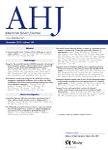版权所有:内蒙古大学图书馆 技术提供:维普资讯• 智图
内蒙古自治区呼和浩特市赛罕区大学西街235号 邮编: 010021

作者机构:Penn State Univ Dept Biobehav Hlth University Pk PA 16802 USA Penn State Univ Hlth Serv 1 PACE Program Harrisburg PA USA Penn State Univ Milton S Hershey Med Ctr Coll Med Dept MedDiv Cardiol Hershey PA 17033 USA
出 版 物:《AMERICAN HEART JOURNAL》 (美国心脏杂志)
年 卷 期:2000年第140卷第4期
页 面:663-671页
核心收录:
学科分类:1002[医学-临床医学] 100201[医学-内科学(含:心血管病、血液病、呼吸系病、消化系病、内分泌与代谢病、肾病、风湿病、传染病)] 10[医学]
主 题:肾上腺素能β受体拮抗剂/治疗应用 猝死 心脏/预防和控制 心电描记术/药物作用 随访研究 心率/药物作用 心率/生理学 心肌梗死/药物疗法 心肌梗死/死亡率 心肌梗死/病理生理学 比值比 门诊病人 宾夕法尼亚/流行病学 处方 药物/统计学和数值数据 预后 回顾性研究 存活率/发展趋势 老年人 老年人 80以上 女(雌)性 人类 男(雄)性
摘 要:Background Results of recent studies suggest that beta-biockers are underused by elderly acute myocardial infarction (AMI) survivors. The goals of this study were to examine changes in post-AMI beta-blocker use occurring between 1994 and 1997 and to identify factors associated with outpatient use of beta-blockers. Methods Patients included 9534 individuals greater than or equal to 65 years of age who were enrolled in Pennsylvania s Pharmaceutical Assistance Contract for the Elderly (PACE) and who survived AMI between 1994 and 1997. With the use of outpatient prescription claims, beta-blocker usage rates were examined by year, and multivariate logistic regression was used to identify predictors of beta-blocker use. Results Post-AMI beta-blocker use increased from 39.6% in 1994 to 58.6% in 1997. Controlling for AMI year, individuals who had any prescriptions written by a cardiologist were more likely to use a beta-blocker than individuals who received all prescriptions from noncardiologists (odds ratio 1.52, P = .0001). Elderly patients who did not use beta-blockers tended to have greater severity of illness, non-Q-wave infarctions, atrial fibrillation, and comorbidities such as congestive heart failure, chronic obstructive pulmonary disease, and asthma. Use of calcium channel blockers and diuretics was negatively associated with beta-blocker use, but persons using lipid-lowering agents were more likely to use beta-blockers. Conclusions Significant improvements in beta-blocker use by elderly AMI survivors have occurred since 1994. Differences among physician specialties in beta-blocker prescribing appear to remain. Across all prescriber specialities, historic contraindications constitute major factors in the choice of post-AM I therapy. Further efforts should be made to encourage the use of beta-blockers in elderly survivors of AMI, particularly those with heart failure.